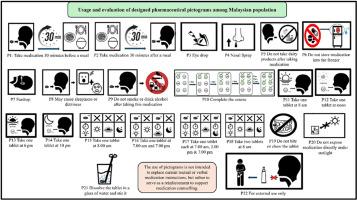Evaluation of designed pharmaceutical pictograms among the Malaysian population
IF 1.7
Q2 PUBLIC, ENVIRONMENTAL & OCCUPATIONAL HEALTH
引用次数: 0
Abstract
Background
Poor medication adherence to treatment regimen and medication errors among patients are the main concerns for pharmacists. One creative way to make medical information easier to understand, improve health literacy, and be more memorable for patients is through simple, culturally relevant, and context-specific pharmaceutical pictograms.
Objectives
This study evaluated the understanding of the population in the four regions of Malaysia regarding 22 designed Malaysian pictograms.
Materials and methods
A cross-sectional study was conducted in 800 participants from the four different regions, with 200 participants from each region, using a convenience sampling method. Their interpretations of pictograms were classified and recorded. The correct recognition rate was used to determine whether each pictogram had met the ISO criterion of ≥66.7 % or the ANSI criterion of ≥85 %.
Results
Seventeen pictograms met the ISO criteria of >67 %, while seven pictograms met the ANSI criteria of >85 % before the explanation was provided. After the explanation, all pictograms met the ISO criteria, but only two pictograms did not meet the ANSI criteria. There was a significant difference in interpretation performance before and after the explanations were given.
Conclusion
The pictograms are suitable for introduction and can effectively convey medication-related information when used alongside verbal explanations and simple texts. This can improve communication and facilitate health education.

马来西亚人口中设计的药物象形图的评价
患者对治疗方案的依从性差和用药错误是药剂师关注的主要问题。一种使医学信息更容易理解、提高健康素养并让患者更容易记住的创造性方法是使用简单、与文化相关且特定于情境的药物象形图。目的本研究评估了马来西亚四个地区的人口对22个设计的马来西亚象形图的理解。材料与方法采用方便抽样法,对来自四个不同地区的800名参与者进行了横断面研究,每个地区200名参与者。他们对象形文字的解释被分类并记录下来。使用正确识别率来确定每个象形文字是否满足ISO标准≥66.7%或ANSI标准≥85%。结果说明前,17个象形图符合ISO标准67%,7个象形图符合ANSI标准85%。经过解释,所有象形图都符合ISO标准,但只有两个象形图不符合ANSI标准。学生在进行解释前后的解释表现有显著差异。结论象形文字与口头说明、简单文字配合使用,可有效传达药物相关信息。这可以改善沟通,促进健康教育。
本文章由计算机程序翻译,如有差异,请以英文原文为准。
求助全文
约1分钟内获得全文
求助全文
来源期刊

Clinical Epidemiology and Global Health
PUBLIC, ENVIRONMENTAL & OCCUPATIONAL HEALTH-
CiteScore
4.60
自引率
7.70%
发文量
218
审稿时长
66 days
期刊介绍:
Clinical Epidemiology and Global Health (CEGH) is a multidisciplinary journal and it is published four times (March, June, September, December) a year. The mandate of CEGH is to promote articles on clinical epidemiology with focus on developing countries in the context of global health. We also accept articles from other countries. It publishes original research work across all disciplines of medicine and allied sciences, related to clinical epidemiology and global health. The journal publishes Original articles, Review articles, Evidence Summaries, Letters to the Editor. All articles published in CEGH are peer-reviewed and published online for immediate access and citation.
 求助内容:
求助内容: 应助结果提醒方式:
应助结果提醒方式:


